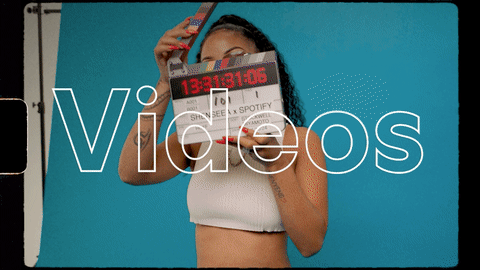Glossary of Music Terms is an ongoing series where we zoom in on a corner of the music industry to demystify its terminology. Check out our previous installments on Distribution, Recording, and Live Performances.
There are many music terms whose meanings have been understood for decades, but in the streaming era, lots of new ones have popped up, and others have taken on new meanings thanks to the ways experiencing and enjoying music have changed. For this glossary, we put together a number of definitions of these terms with a focus on their significance in the digital audio streaming world.
Bitrate: Bitrate refers to the speed at which data is transferred from one location to another; it is measured in kilobits per second (kbps). Audio files are compressed to many different bitrates. Two of the more common ones are 192 kbps and 256 kbps. An MP3 that is compressed at a higher bitrate will usually sound more clear and have a bigger range of sound than one compressed at a lower bitrate.
Distributor: A distributor is the entity that takes your music from you or a record label and makes it available in a store or streaming service. They also help ensure that royalties—the money you or other rights holders are entitled to for use of your work—are paid out to the correct parties. Distributors can help get your music in the hands of people all over the world by sending it through the right channels.
End-user: An end-user is the person who actually consumes (uses) a particular product. In digital streaming, the end-user is a listener—which can be just about anyone, including a fan, researcher, booking agent, and beyond. It’s good practice to keep the end-user in mind when prepping something for digital distribution.
ISRC: An ISRC (International Standard Recording Code) is a string of 12 alphanumeric characters that is used to identify any sound recording or music video. ISRCs are like ISBNs for books or VINs for cars—no two are identical. ISRCs make recordings automatically identifiable, which helps ensure that royalties are properly distributed.
File format: Audio files come in many different formats, with varying sizes and sound quality. Here’s a rundown of some of the most popular ones.
MP3: MP3 (MPEG-1 Audio Layer 3) files are what everyone usually thinks of when they think of an audio file. It’s the most popular audio format on the planet. MP3s use lossy data compression—"lossy" literally refers to the loss of data—as the larger original audio file is compressed to the MP3 format.
AAC: AAC (Advanced Audio Coding) is also a popular format, but it hasn't reached the level of ubiquity that MP3s have. AAC files use a more advanced compression algorithm—but still lossy, like the MP3—so that at the same bitrate, it’s typical for an AAC file to sound better than an MP3.
WAV: WAV is a raw audio format, and it typically contains lossless (or uncompressed) audio, which means it can preserve all of the original audio file’s data. It’s desirable to have WAVs on hand as well as MP3s for many reasons, particularly for maximum sound quality.
FLAC: FLAC (Free Lossless Audio Codec) files are another example of lossless audio, but there’s not much technical support for them—as in, you can play an MP3, AAC, or WAV file on almost any device, but not FLACs.
Metadata: Let us be clear—metadata is so important that we already have an entire stand-alone article dedicated to explaining it and why it’s essential. In short, metadata is the data about your audio files, which is embedded in them. It includes, among other things, artist name, song title, album title, year of release, songwriter credits, and genre. Without accurate and complete metadata, your files aren't searchable, won't display correctly, and royalty distribution can't happen.
Playlists: Playlists are collections of songs by one or more artists that are tied together by some concept, which could be just about anything—it could be the mood they create or some common thread between the artists who created the songs or even just a specific lyrical theme. They are a great way to get your tunes into the ears of fans and potential fans; they're the digital-world equivalent of mixtapes. Playlists can be curated (a fancy word for choosing the songs for any given playlist) and shared by casual users of most streaming music services, or by in-house experts at streaming services, or by DJs or artists who love to share their inspirations and ideas—basically anyone can create and share a playlist. (And "playlisting" itself has become a verb to describe the process of creating them.) Getting placement on a playlist can give a big boost to your streaming numbers; it can happen when a curator or fan finds their way to your music by following their own discovery paths, but pitching your music for playlist consideration via Spotify for Artists is another way to get your songs into the ears of our in-house curators (here's how).
Pre-save: Pre-saving in the streaming world is just like pre-ordering an album in the physical one; it's how a fan indicates that they want information and digital access to new music the moment it is available. When a Spotify user pre-saves your upcoming release, they ensure it'll appear in their Spotify library the day it drops. Encouraging your fans to pre-save the tracks you’ve got coming up can help as a call to action during your rollouts and will get your songs in the hands of more people on release day.
RIAA certification requirements: Now that we’re in the streaming era, the Recording Industry Association of America (RIAA) has different certifications for what kind of numbers make a release gold, platinum, multi-platinum, and diamond. An album or song has to hit a certain number of units to obtain any of those certifications. Gold, for example, is 500,000 units. But one stream doesn’t equal one unit. According to the RIAA website regarding Album Awards, each permanent digital or physical album sale counts as one unit, ten permanent track downloads from the album count as one unit, and 1,500 on-demand audio and/or video streams from the album count as one unit. For Digital Single Awards, each permanent digital download counts as one unit, and 150 on-demand audio or video streams count as one unit.
Royalties: Whenever someone uses your intellectual property, they usually have to pay for the right to do so and those payments are usually in the form of royalties. Royalties come in many shapes and sizes depending on what rights are being used. Some kinds of royalties relate solely to musical compositions, as opposed to a recording, and those relate to reproduction rights (a so-called “mechanical royalty”) or performance rights. Other royalties relate solely to the reproduction and performance of a track or sound recording. So every time your music is played on Spotify, and depending on what country that play is happening in, there could be several different kinds of royalties paid to various parties such as a record label, music publishers, or collection societies.
Territory: Territories are the geographical divisions that are used to define where various rules apply to your music; most music-licensing agreements will have specifications around territories, indicating whether and how your music can be used inside (or outside) those territories. Simply put: Your music cannot be streamed in a territory where it isn’t licensed. (This is why, for instance, certain YouTube videos that you can watch in the US aren’t available in Canada—that intellectual property has not been licensed for distribution in Canada.) If there are no territory restrictions on your music, you can set it up on streaming services to be available worldwide.
Verification: Being verified on Spotify means we’ve confirmed you are who you say you are, and we’ve noted that on your page with a checkmark in a little blue circle so everyone will know. We’ve made it very simple to get verified on Spotify via the Spotify for Artists app.
—Matt Williams






